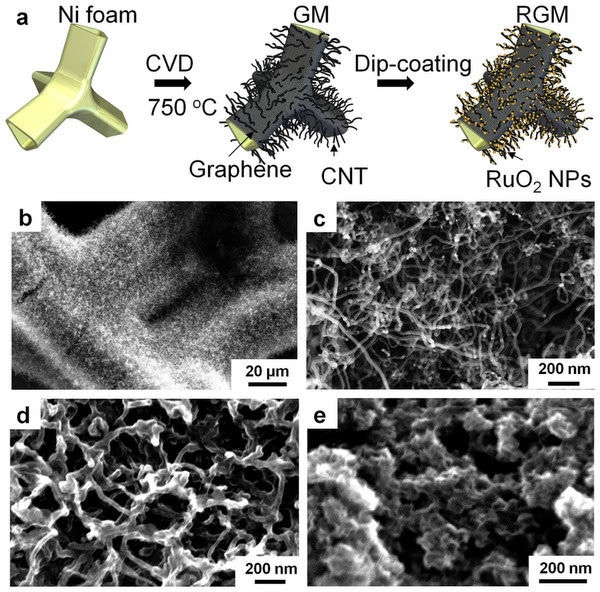As reported today by Sean Nealon, UC Riverside, Researchers at the Univ. of California, Riverside have developed a novel nanometer scale ruthenium oxide anchored nanocarbon graphene foam architecture that improves the performance of supercapacitors, a development that could mean faster acceleration in electric vehicles and longer battery life in portable electronics.
Read the full story here in the R&D Mag or check out the original OPEN ACCESS publication bellow:
Read the full story here in the R&D Mag or check out the original OPEN ACCESS publication bellow:
Wei Wang, Shirui Guo, Ilkeun Lee, Kazi Ahmed, Jiebin Zhong, Zachary Favors, Francisco Zaera, Mihrimah Ozkan & Cengiz S. Ozkan
Scientific Reports 4, Article number: 4452 doi:10.1038/srep04452, 25 March 2014
Abstract: In real life applications, supercapacitors (SCs) often can only be used as part of a hybrid system together with other high energy storage devices due to their relatively lower energy density in comparison to other types of energy storage devices such as batteries and fuel cells. Increasing the energy density of SCs will have a huge impact on the development of future energy storage devices by broadening the area of application for SCs. Here, we report a simple and scalable way of preparing a three-dimensional (3D) sub-5 nm hydrous ruthenium oxide (RuO2) anchored graphene and CNT hybrid foam (RGM) architecture for high-performance supercapacitor electrodes. This RGM architecture demonstrates a novel graphene foam conformally covered with hybrid networks of RuO2 nanoparticles and anchored CNTs. SCs based on RGM show superior gravimetric and per-area capacitive performance (specific capacitance: 502.78 F g−1, areal capacitance: 1.11 F cm−2) which leads to an exceptionally high energy density of 39.28 Wh kg−1 and power density of 128.01 kW kg−1. The electrochemical stability, excellent capacitive performance, and the ease of preparation suggest this RGM system is promising for future energy storage applications.
(a) Schematic illustration of the preparation process of RGM nanostructure foam. SEM images of (b–c) as-grown GM foam (d) Lightly loaded RGM, and (e) heavily loaded RGM. (Source : article above)
Check out the performance in this Ragone plot - Woah - pretty high energy density material!
(a) EIS plots and (b) high frequency region EIS plots of GM, RGM, a control sample (RuO2 nanoparticles only), respectively. (c) Ragone plot related to energy densities and power densities of the packaged whole cell RGM SC, GM SC, RuO2 nanoparticles SC, hydrous ruthenium oxide (RuO2)/graphene sheets composite (GOGSC), RuO2 nanowire/single walled carbon nanotube (SWNT) hybrid film. (Source: articlew above)
(a) EIS plots and (b) high frequency region EIS plots of GM, RGM, a control sample (RuO2 nanoparticles only), respectively. (c) Ragone plot related to energy densities and power densities of the packaged whole cell RGM SC, GM SC, RuO2 nanoparticles SC, hydrous ruthenium oxide (RuO2)/graphene sheets composite (GOGSC), RuO2 nanowire/single walled carbon nanotube (SWNT) hybrid film. (Source: articlew above)



%20(1).png)


https://www.guest-articles.com/education/for-instant-success-try-real-nutanix-ncse-level-1-dumps-09-10-2020
ReplyDeleteAs reported today by Sean Nealon, UC Riverside, Researchers at the Univ. of California, Riverside have developed a novel nanometer scale ruthenium oxide anchored nanocarbon graphene foam architecture that improves the performance of supercapacitors, a development that could mean faster acceleration in electric vehicles and longer battery life in portable electronics.
ReplyDeleteLee Andrew McCutcheon is a tough and competitive bodybuilder. He is a former ‘International Federation of BodyBuilders (IFBB) and a professional bodybuilder and a current National Amateur Body Builder’ Association (NABBA) Professional athlete’. Since childhood, he embarked on practicing its training and he also got the support of his grandfather. lee priest height
ReplyDelete